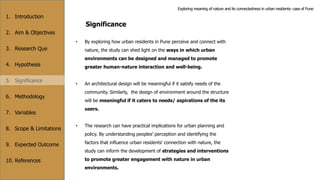research proposal jury presentation.pptx
- 1. RESEARCH IN ARCHITECTURE- I RESEARCH PROPOSAL Topic: Exploring meaning of nature and its connectedness in urban residents- case of Pune Isha S. Chiplunkar Third Year B. Arch., BKPS College of Architecture, Pune Guide: Dr. Abhijit Natu
- 2. 1. Introduction 2. Aim & Objectives 3. Research Que 4. Hypothesis 5. Significance 6. Methodology 7. Variables 8. Scope & Limitations 9. Expected Outcome 10. References Exploring meaning of nature and its connectedness in urban residents- case of Pune Introduction • Scenes of nature have shown improvements in cognitive and executive attention, which can improve task focus and reduces the effects of unwanted distractions. • It is a well known fact that visual scenes containing nature have been found to influence temporal perception, whereby exposure to natural elements creates the perception of peace and happiness to mind. • But rampant urbanization of cities around the world has led to a growing disconnect between humans and nature, as concrete jungles replace natural habitats • Hence finding elements considered as “nature” by urban residents, where and how often and effortlessly they get a chance to interact with nature may be helpful while bringing nature into designed urban settings
- 3. 1. Introduction 2. Aim & Objectives 3. Research Que 4. Hypothesis 5. Significance 6. Methodology 7. Variables 8. Scope & Limitations 9. Expected Outcome 10. References Aim To investigate Pune’s urban residents’ idea of nature and identifying their places of interaction with nature Objectives To investigate urban residents’ idea/ perception of the term “nature” To identify landscape elements constituting residents’ idea of nature in their day-to-day life To identify the places of human nature interface in day-to-day life Exploring meaning of nature and its connectedness in urban residents- case of Pune
- 4. 1. Introduction 2. Aim & Objectives 3. Research Que 4. Hypothesis 5. Significance 6. Methodology 7. Variables 8. Scope & Limitations 9. Expected Outcome 10. References Research Questions What is the meaning of “nature” for the urban residents? Where do they find this nature in their day to day lives? Do the demographics of open space users and the distribution of open spaces within a region influence connections? What are the landscape elements that constitute to peoples’ perception of nature? How does the urban/ rural background of childhood affect the meaning/ connection to nature in adult life? Hypothesis …… Exploring meaning of nature and its connectedness in urban residents- case of Pune
- 5. 1. Introduction 2. Aim & Objectives 3. Research Que 4. Hypothesis 5. Significance 6. Methodology 7. Variables 8. Scope & Limitations 9. Expected Outcome 10. References Significance • By exploring how urban residents in Pune perceive and connect with nature, the study can shed light on the ways in which urban environments can be designed and managed to promote greater human-nature interaction and well-being. • An architectural design will be meaningful if it satisfy needs of the community. Similarly, the design of environment around the structure will be meaningful if it caters to needs/ aspirations of the its users. • The research can have practical implications for urban planning and policy. By understanding peoples’ perception and identifying the factors that influence urban residents' connection with nature, the study can inform the development of strategies and interventions to promote greater engagement with nature in urban environments. Exploring meaning of nature and its connectedness in urban residents- case of Pune
- 6. 1. Introduction 2. Aim & Objectives 3. Research Que 4. Hypothesis 5. Significance 6. Methodology 7. Variables 8. Scope & Limitations 9. Expected Outcome 10. References Methodology Qualitative study in form of face to face interview to explore the subjective experiences of residents and their relationship with nature. Cognitive mapping Who is studied? The random sampling of people between age to living in urban residences residing in various areas of the city The study is carried out at a single instance i.e., cross-sectional study Unit of Analysis- residents of Pune Independent variable- landscape characteristics of urban neighbourhood Dependent variable-perception of nature, nature connectedness Exploring meaning of nature and its connectedness in urban residents- case of Pune
- 7. 1. Introduction 2. Aim & Objectives 3. Research Que 4. Hypothesis 5. Significance 6. Methodology 7. Variables 8. Scope & Limitations 9. Expected Outcome 10. References Scope The study has a scope to reveal which landscape elements do people perceive as nature in an urban context The study would help understand the impact of urbanization on people's connection to nature The research will help in designing more relevant spaces while planning urban surroundings Limitation • This research is restricted to the urban residential settlement in Pune city only • Only adults are involved in this study as samples • It is a cross sectional study
- 8. 1. Introduction 2. Aim & Objectives 3. Research Que 4. Hypothesis 5. Significance 6. Methodology 7. Variables 8. Scope & Limitations 9. Expected Outcome 10. References Expected outcome • Acquiring data about which landscape elements do people consider as nature in urban context • Findings about reality of human nature interface in urban areas and the impact of urbanization on urban residents’ nature connection • Understanding the meaning of nature and its connectedness to urban residents in Pune can help identify ways to enhance the health and well-being of the city's residents • Understanding what people consider as nature can help urban designers identify opportunities to integrate nature in day-to-day life through urban planning. Exploring meaning of nature and its connectedness in urban residents- case of Pune
- 9. 1. Introduction 2. Aim & Objectives 3. Research Que 4. Hypothesis 5. Significance 6. Methodology 7. Variables 8. Scope & Limitations 9. Expected Outcome 10. References References Exploring meaning of nature and its connectedness in urban residents- case of Pune








